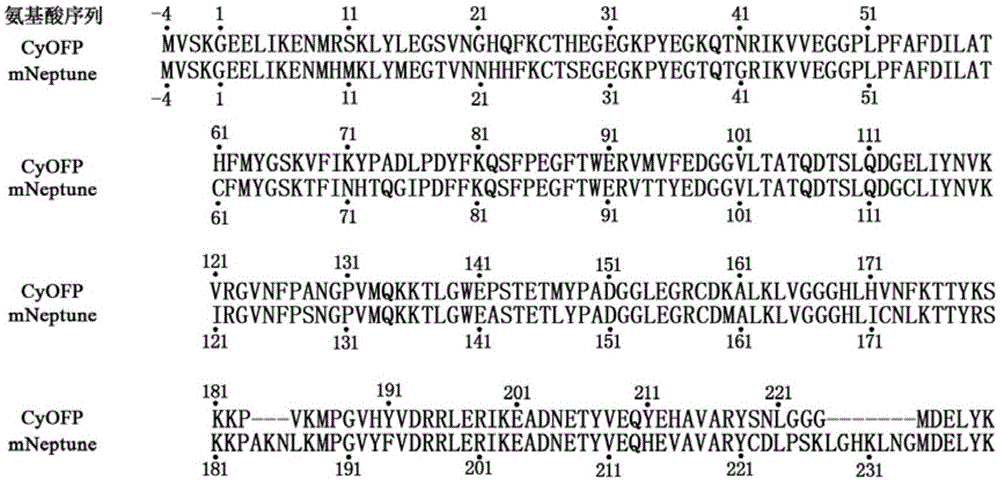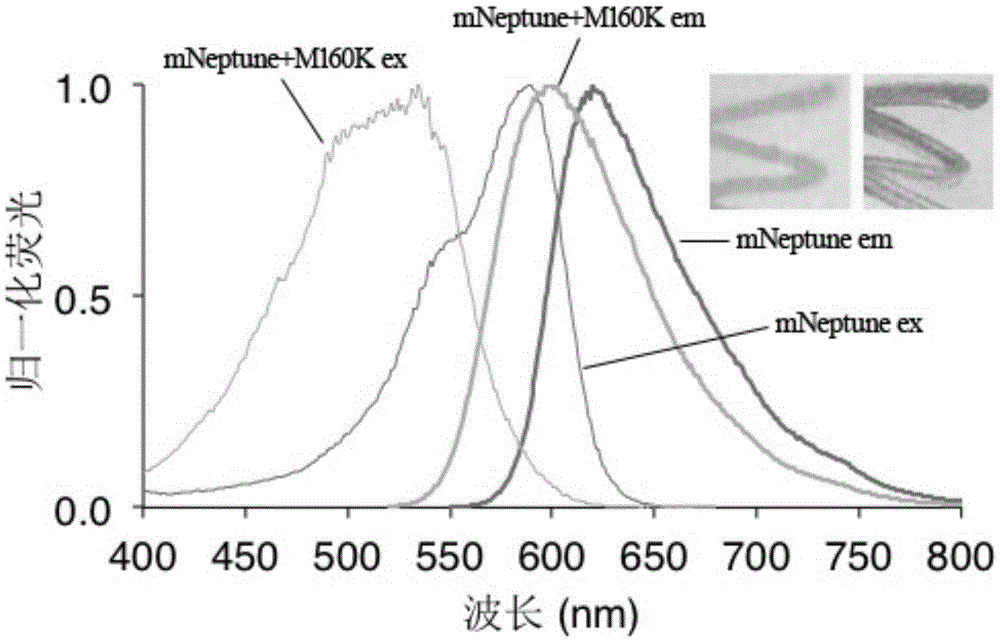Large stokes displacement fluorescent protein CyOFP and application thereof
A fluorescent protein and Stokes technology, applied in the field of biomedical optics and molecular imaging, can solve the problems of unsatisfactory two-photon synchronous imaging BRET system, low sensitivity of two-photon imaging, shallow depth of in vivo imaging, etc., to achieve Effect of improved penetration, improved depth and sensitivity, strong fluorescent signal and sensitivity
- Summary
- Abstract
- Description
- Claims
- Application Information
AI Technical Summary
Problems solved by technology
Method used
Image
Examples
Embodiment 1
[0055] This embodiment provides a large Stokes shift fluorescent protein CyOFP, which is obtained by site-directed mutagenesis screening on the basis of the far-infrared fluorescent protein mNeptune, and its acquisition process is as follows:
[0056] Carry out site-directed mutagenesis to the far-infrared fluorescent protein mNeptune, wherein the 1-240th positions of the amino acid sequence of mNeptune correspond to the 4th-244th positions shown in SEQIDNo: 1; then carry out the mutant on the constitutive expression vector pNCS For expression and screening, the expression strain used was XL-10Gold (purchased from Agilent Technologies). In order to ensure the integrity of the library, 10 clones were set up for each mutant, which was finally distinguished by naked eyes and blue LED excitation light through an orange acrylic filter Detect the fluorescent properties of the mutant, and screen out a single clone expressing a fluorescent protein with a large Stokes shift. The fluores...
Embodiment 2
[0061] Example 2 Functional experiments corresponding to mutation sites
[0062] (1) Experiments embodying Stokes shift
[0063] The mNeptune was randomly mutated and screened by error-prone PCR method, and the bacterial single clone with an orange color was selected. Through sequencing, the fluorescent protein with only the M160K mutation site was screened out, which was mNeptune+M160K.
[0064] Take 150 microliters of purified protein and place it in a black 96-well plate, and measure the excitation and emission spectra using a SafireII multifunctional microplate reader from Tecan Company. Such as image 3 as shown, image 3 For this example fluorescent protein "mNeptune+M160K" and mNeptune excitation and emission spectrum comparison chart, image 3 The picture in the upper right corner of the curve is a white light picture of bacteria expressing mNeptune and mNeptune-M160K.
[0065] Depend on image 3 It can be seen that M160K can cause the excitation and emission of m...
Embodiment 3
[0078] Embodiment 3CyOFP excitation spectrum and emission spectrum test experiment
[0079] B-PERII (purchased from Pierce Company) was used to lyse the bacterial strain expressing CyOFP in the above example 1, and then HisPurCobaltResin (purchased from Pierce Company) was used to purify the protein, followed by an Econo-Pac10DG gravity flow chromatography column (purchased from Bio -Rad) to salt. After completing the above protein purification steps, use a Lambda35UV / VISandLS-55 fluorescence spectrometer (purchased from PerkinElmer) to detect the excitation and emission spectra of CyOFP, as Figure 7 shown; in addition, the comparison between CyOFP and some red fluorescent proteins in terms of quantum yield is shown in Table 3.
[0080] table 3
[0081]
[0082]
[0083] Experimental results show that: CyOFP has a wide range of excitation spectrum, and can still maintain more than 95% of the highest excitation efficiency between 488-526nm. The emission peak of CyOFP ...
PUM
 Login to View More
Login to View More Abstract
Description
Claims
Application Information
 Login to View More
Login to View More - R&D
- Intellectual Property
- Life Sciences
- Materials
- Tech Scout
- Unparalleled Data Quality
- Higher Quality Content
- 60% Fewer Hallucinations
Browse by: Latest US Patents, China's latest patents, Technical Efficacy Thesaurus, Application Domain, Technology Topic, Popular Technical Reports.
© 2025 PatSnap. All rights reserved.Legal|Privacy policy|Modern Slavery Act Transparency Statement|Sitemap|About US| Contact US: help@patsnap.com



